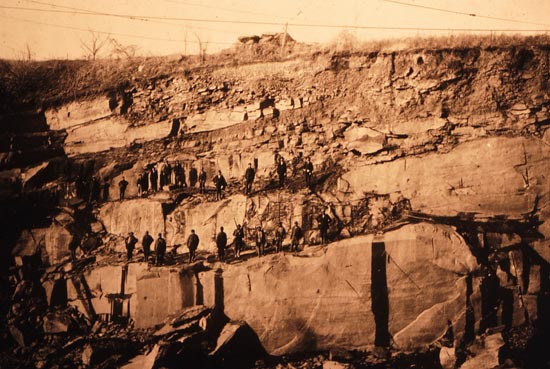 The Smithsonian Castle is one of the most striking buildings on the National Mall in Washington, DC. One reason for this is its distinctive architecture, but a second reason is its color: a bright, deep red. This color comes from the rock from which the Castle constructed: the Triassic-aged “Seneca Sandstone,” a part of the formation technically known as the Manassas Sandstone. It is overlain by the Balls Bluff Siltstone, the most extensive geologic unit within the Culpeper Basin. The Culpeper Basin is part of the Newark Supergroup basins – extensional, normal-fault-bounded grabens and half-grabens that opened up in the early Mesozoic when the supercontinent Pangea was breaking up and the Atlantic Ocean was first forming.
The Smithsonian Castle is one of the most striking buildings on the National Mall in Washington, DC. One reason for this is its distinctive architecture, but a second reason is its color: a bright, deep red. This color comes from the rock from which the Castle constructed: the Triassic-aged “Seneca Sandstone,” a part of the formation technically known as the Manassas Sandstone. It is overlain by the Balls Bluff Siltstone, the most extensive geologic unit within the Culpeper Basin. The Culpeper Basin is part of the Newark Supergroup basins – extensional, normal-fault-bounded grabens and half-grabens that opened up in the early Mesozoic when the supercontinent Pangea was breaking up and the Atlantic Ocean was first forming.
The new book The Smithsonian Castle and the Seneca Quarry, by local historian Garrett Peck, tells the history of the extraction, use, and historical tie-ins associated with this rock. The History Press kindly provided me with a review copy of the book. I enjoyed reading it, but mostly it’s written about things I wouldn’t ordinarily pursue – economics, political scandals, the machinations of landowners and family members. The book features some beautiful color plates which showcase the stone’s unique color very nicely. It’s a gorgeous rock.
There is very little geology in the book. It’s mainly a historical study of the “stone” (stone being “rock you pay money for”) rather than the rock itself. There is a small 2-page spread on the geological origins of the Seneca Sandstone, but it’s pretty paltry stuff if you already speak geology. This was a disappointment to me as a geologically-inclined reader. It’s a shame to gloss over the story of this rock, because it’s actually pretty doggone epic. The breakup of Pangea, the birth of the Atlantic, the role of contingency in geologic history with regard to DC’s Piedmont rocks – in the Triassic, there was a rift valley on each side: one to the east, and one to the west. As it turns out, the one to the east kept opening, and became the Atlantic Ocean, while the one to the west “failed” and filled in with sediment and mafic lavas – the Culpeper Basin. I think it’s worth a paragraph of speculation to imagine what would have happened if it had gone the other way… the Culpeper Ocean would have its western shore in Leesburg, Virginia, and the Piedmont rocks would be part of the Western Sahara province of Morocco instead of the site of the US capital city. Somewhere deep in the Sahara, there would be a rift basin full of arkose and siltstone and diabase called the Atlantic Basin.
And what about the great animals (dinosaurs, lake fish) we find fossilized in the Culpeper Basin? They have great stories to tell, too.
The one geological insight I got from reading the book was viewing this picture of the Seneca Quarry, taken in the 1890s:

Seneca Stone Quarry c.1890s (Photo source: Maryland-National Capital Park & Planning Commission)
This site is now incredibly overgrown with trees and vines. But just over a century ago, you can see a beautiful stack of river channel sands and interleaved floodplain shales. It’s gorgeous. The photo is presented as evidence of the segregation of the quarry workforce, but to my eyes, it’s one of the most insightful images as to the origins of this rock that I’ve ever seen. It strikes me as a critical document of the past condition of this site, and it reinforces my decision to spend time documenting geology in the present day with photos and GigaPans, so that the information fossilized in these outcrops may be preserved for future generations.
